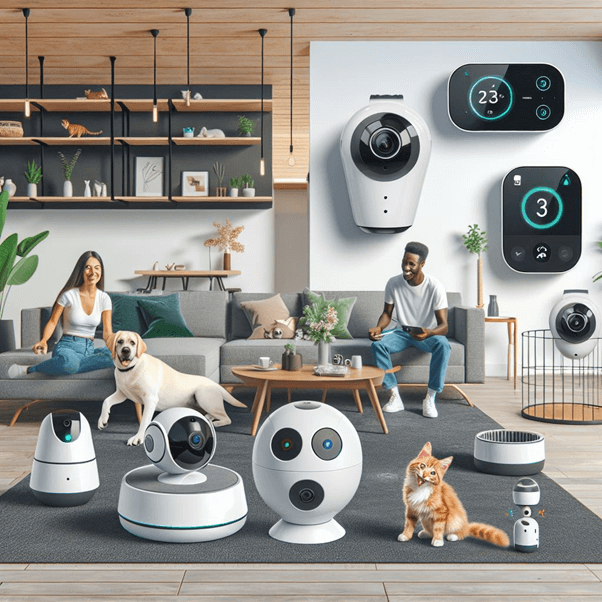The Evolution of the Pet Assistive Devices Market: Helping Pets Live Better Lives
Published Date: 21 Oct 2024
As Pet ownership continues to increase, there is also a growing interest and concern for pet care and well-being. The consideration or increased use of assistance devices for pets reflects an increasing willingness to consider pets as members of our family and fulfill our assistive approach to their needs.

Types of Assistive Technology and Service
Individuals with disabilities can choose from a wide range of assistive technologies and services based on their specific requirements and preferences. Here are some examples of assistive technology:
- Wheelchairs and mobility devices.
- Hearing Aids and Cochlear Implants
- Screen readers and magnifiers.
- Braille screens and refreshable Braille devices.
- Voice recognition software and speech-to-text tools.
How the Pet assistive Devices market changes Pet Life
The Rise of Online Shopping makes it easier for consumers to assess specialized pet products
The online shopping landscape has changed the pet assistive device market by increasing the accessibility of niche products for pet owners, there is ever-growing awareness for pets’ health, and online ease of access in obtaining information, product reviews, and recommendations is driving the market. According to the American Pet Products Association’s 2021-2022 “National Pet Owners Survey,” around 70% of American homes have pets. Online Shopping has increased consumers’ ability to feel informed about their purchasing decisions.
Premium pricing can deter budget-conscious pet Owners from purchasing assistive devices
The high prices associated with pet assistive devices significantly restrain market growth. These devices come with a steep price, dissuading buyers looking for low-priced products to stay away from them. The low priority assigned to such fancy devices in pet care expenses is stymieing the market's growth as budget-conscious owners focus on basic needs and avoid purchasing these devices. The availability of too many similar products has resulted in a cluttered market. High prices can make many pet owners unable to access these devices, Creating a limited customer base for advantageous devices.
Offering customizable assistive devices tailored to individual pet needs can attract more customers
The Provision of customizable assistive devices to meet the unique needs of pets is a significant opportunity in the market of pet assistive devices. Pet owners are increasingly seeking customized pet solutions based on a pet’s age, health problem, or even a pet’s physical variations. Custom options give pet owners a sense of connection as they recognize that pet needs are being specifically addressed while increasing customer satisfaction and loyalty to the brand.
The offer of customization emphasizes a brand’s position against the competition and perceived attractiveness to the consumer. Customizable products also may create more profitability, as pet owners may be willing to pay a premium for customized solutions. Thus, customizability is a growing and driving force in the pet assistive device market for innovation and growth, allowing a brand to create expansion for new consumer segments.
Competitive Landscape
The pet assistive devices market is highly competitive as the demand for mobility devices for pets with disabilities is rising. Pet Safe, Walkin’ Pets, and K9 Carts are leading players in the market with an increasing number of options to improve the mobility and comfort of their products for pets. Orthopedic beds for senior pets are being rolled out by Pet Safe and Walkin’ Pets, offering adjustable wheelchairs for better sizing and comfort.
The appeal of the pet care market is expanding beyond mobile aids. Companies like Dog Quality reflect a trend toward all-day care for pets by providing new supportive harshnesses and therapeutic options. The Competition is also being driven by technology and innovations, resulting in assistive devices for pets being more effective and easier to use by the owner.
Challenges
The market for pet assistive gadgets is expanding, yet there are certain challenges, such as
Regulatory compliance. Compliance with regulations may restrict the number of enterprises that can enter the market.
The concentration of distribution channels impacts market competition and accessibility.
There are few obvious substitutes for pet mobility aids. However, owners can manually assist their pets.
Conclusion
The evolution of the pet care industry is a story of innovation, sustainability, and deep empathy for pets. As we've seen, brands at the forefront of this change, like as Kismet and Chewy, aren't just following trends; they're creating them, supporting a future in which pet care is synonymous with quality, ease, and compassion. From the pandemic-induced pet boom to the most recent technological developments, the future of pet care is looking brighter and more connected for pets and their human companions.
Maximize your value and knowledge with our 5 Reports-in-1 Bundle - over 40% off!
Our analysts are ready to help you immediately.
